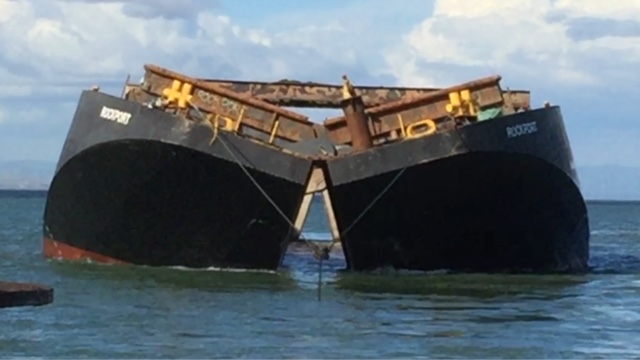Somebody asked me about my schedule down here in San Francisco Bay and my duties, so I thought it would be fun to do a "day in the life of", for this current dredge job.
Me: 2nd Mate on the Gene Dunlap Ocean Tug.
The Contract: Dredge job for Manson Construction near Richmond, that will be a 3-month job, dredging mostly the Richmond channel at the outer entrance, outer harbor near the long-wharf and the inner harbor that leads to the marinas.
We were hired to move and empty the dump skows (220'+ barges that open and close for dumping). Each barge holds about 3000-4000 cubic yards of material. We have 3 skows, 2 that we rotate and one for backup.
There are 3 dump sites: one is SF10, which is our currently used site, and it's about 6 miles to the north-northeast in San Pablo Bay. The next one is offshore near the Farralone Islands (SFDOD), approx 60 miles from the dredging area and won't be used until we begin dredging the inner harbor in November.
The 3rd disposal site is about 35 miles northeast up near Antioch and Pittsburgh.
Right now, it's just our crew and one boat (Gene Dunlap) doing the dump runs
However next month the Snohomish will be joining our efforts as we begin the offshore runs.
The daily grind.
We have 3 deck officers (One Captain and two Mates), and the mates are working a 6 on, 6 off rotation while the Captain floats and gets up when needed, which is usually during tricky maneuvering and landings.
I'm working the 6-12 watch morning and evening, so my day goes something like this.
05:25 alarm clock. Get up, throw some clothes on, hit the head (use the bathroom AND hit my noggin since I'm sleeping in a short bunk), then roll into the galley for a bowl of cereal and some fresh fruit (special thanks to our cook for that daily treat). After that, I make a cup of coffee and head up to the wheelhouse to take the watch around 05:45.
If nothing is happening, I basically sit in the wheelhouse, fill out some paperwork and monitor VTS Ch 14 and our working channel 66 for the dredge itself, and basically stand an anchor watch.
In between dumping barges, we anchor
Near the dredge on our tow wire by letting out extra wire and locking us in place.
When the dredge has a loaded barge for us ready to go, they give us a one-hour heads up and we fire up the mains (main engines). It takes the dredge anywhere from 4-8 hours to fully load a barge.
We then reel in our empty barge, break tow (disconnect), let the other assist tug come and take it from us, then we head to the dredge to make up tow on the fully loaded skow.
Once we've connected our tow wire, the dredge crew drops the lines and we pull away. As soon as that happens and the captain has us clear of the dredge, I take the helm and drive us up to the disposal site (SF10,) which takes about 45 minutes or so. Once we get there, I throttle down, scrub speed and bring the tug/barge into the site using special GPS software provided to us by the Army Corp of Engineers. They track every movement of the barge and are very specific about where we dump. It must happen within the small site, or fines will be assessed.
Once the software shows that the barge is safely inside the box, we use a remote transmitter to fire up the barge engine and begin the opening process.
After we get the barge opening, it begins to dump and rise up. The opening process takes about 6-10 minutes, but it can take up to 20 minutes or so to completely empty. After we are convinced that most of the material is gone (judging it by the draft lines), we close it up and power down the engines.
Then we throttle up the boat and head back to anchorage number 5, just south of the Richmond bridge and wait for the next call.
We've been averaging about 2 dumps per day, sometimes more sometimes less depending on whether the dredge has to move out of the channel, for passing ships.
Once 12 rolls around, I get relieved by the other mate, I'll grab some lunch and hit my rack for some sleep, maybe a movie or a book, then do it all over again
6 hours later starting with dinner at 17:00 and a cup of coffee, finishing out my day at midnight.
The weather has been great, the views awesome, and I can't really complain about much. We also have really good internet and phone signal, which helps ease the pain. The 6 and 6 rotation kinda sucks, but considering the facts, it's a pretty good gig.
When not on watch, I go out on deck and soak up the sun, watch the yachts go by and enjoy the views.
I've been getting a ton of "stick time", landing barges on buoys, moving barges from moorings to docks and back, and have become quite comfortable with the maneuverings, and keeping the barge in the postage stamp sized dump site.
I'll be onboard for another 2 weeks and then home for about a month. Hopefully I'll be back down here for another hitch in December to finish out the job.











